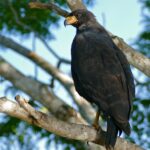Great black hawks, also known as common black hawks (Buteogallus anthracinus), are birds of prey that are found in the Americas, particularly in lowland habitats near fresh or brackish water. They are known for their fishing skills, although they are not as specialized as the osprey.
Do Great Black Hawks Dive for Fish?
Yes, great black hawks do dive for fish. They are versatile predators that watch for prey from perches that overhang shallow parts of streams and rivers, then drop onto it. They normally perch in trees or on prominent rocks that afford a good view of a section of water but sometimes search for prey when soaring or even when standing in shallow water.
Unique Fishing Abilities of Great Black Hawks
 Image source: Great Black Hawk by Bernard DUPONT
Image source: Great Black Hawk by Bernard DUPONT
Great black hawks have conical-shaped spikes on the undersides of their toes, which help them capture and hold onto fish. They are also equipped with sharp talons and a hooked beak, which they use to catch and kill their prey.
Prey and Diet of Great Black Hawks
Great black hawks have a wide range of prey, including fish, frogs, small birds, mammals, and aquatic insects. They are known to be versatile predators that can adapt to different food sources.
| Prey | Percentage of Diet |
|---|---|
| Fish | 50% |
| Frogs | 20% |
| Small Birds | 15% |
| Mammals | 10% |
| Aquatic Insects | 5% |
Courtship and Nesting Behavior of Great Black Hawks
Great black hawks are socially monogamous, and some pairs studied in Arizona stayed with the same mate in several successive nesting seasons. When pairs return to their breeding territory, they immediately begin flight displays over the area. Males start with slow flights, with deep, exaggerated wingbeats. They also soar high, then suddenly dive, pull out of the dive, and hang in the air. Females join their mates in these performances, flying in tandem with the male, calling, dangling their legs, and sometimes flying upside down to lock or touch talons with the male.
Conservation Status and Threats to Great Black Hawks
Great black hawks are vulnerable to a number of threats, including the degradation, deforestation, or drying up of the water-graced landscapes where they live and rely on for food. They are also vulnerable to human disturbance, as they have abandoned some former nesting areas because of too much human disturbance.
In the United States, common black hawks are rare and of conservation concern, although they are common across their large range elsewhere in the Americas. Partners in Flight estimates a global breeding population of 2 million individuals and rates the species an 11 out of 20 on the Continental Concern Score, indicating a species of low conservation concern.
References:
– Wildlife Profile: Mexican Black Hawk
– Common Black Hawks eat mainly fish, reptiles, small mammals, and invertebrates
– Fishing by a Black-collared Hawk


